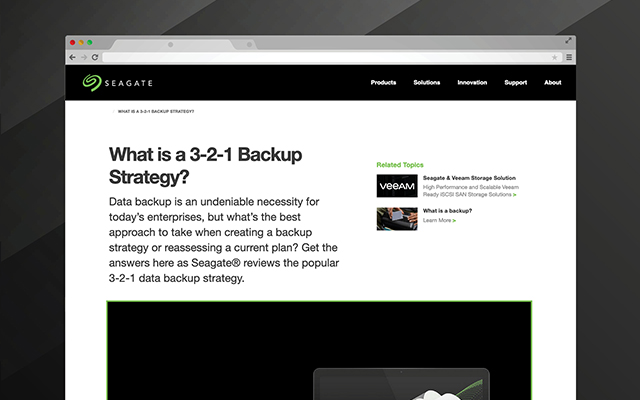What is a 3-2-1 Backup Strategy?
Justifying the need for data backup within any enterprise today should be a simple task. However, determining an organization’s best backup strategy might not be as easy. There are numerous hardware and software options to choose from, and a myriad of suggested policies and procedures describing how to use them. Considering this, some may find it interesting that one of the most popular data backup strategies originated from a creative professional—a photographer who formulated a rule by querying IT professionals—rather than from an IT company or standards organization, as one might have expected.
The 3-2-1 rule, attributed to photographer Peter Krogh, follows these requirements:
- 3 Copies of Data – Maintain three copies of data—the original, and at least two copies.
- 2 Different Media – Use two different media types for storage. This can help reduce any impact that may be attributable to one specific storage media type. It’s your decision as to which storage medium will contain the original data and which will contain any of the additional copies.
- 1 Copy Offsite – Keep one copy offsite to prevent the possibility of data loss due to a site-specific failure.
Krogh formulated his rule almost two decades ago, at a time when his available personal storage options included hard drives with a 30 gigabyte capacity and compact disc backups. Times have certainly changed, and along with them, the available technology. Today’s data storage options include hard drives that can handle up to 18 terabytes and multiple cloud-based solutions. In addition, today’s data storage concerns range well past the amount of drive capacity to include how a selected solution will handle multiple security and failover contingencies.
The 3-2-1 rule should be considered a baseline. However, many organizations mandate more than three copies of managed data. Some may split the data between one or more production, backup (possibly using an alternative media), and disaster recovery sets (potentially offsite). Others may have more unique requirements, but the 3-2-1 rule is as good a place to start as any.
One additional benefit of using the 3-2-1 rule is the ability to perform certain data analytics functions on the data copies (the data stored in backup or disaster recovery infrastructure) rather than on the original data. Along with its seeming simplicity, another benefit to this rule is its allowance for fine-tuning.
3-2-1 Allows for Backup Versatility
In addition to fine-tuning the number of backups, the rule allows for a wide assortment of the type of backups within an organization’s determined strategy, considering intended media types, locations, etc. Multiple considerations can and should be made in specifying backup configurations.
Seagate enterprise systems support the following types of backup targets:
- SAN (iSCSI and Fibre Channel)
- Object storage backup targets using Application Platform (AP)
Selecting different backup types can provide additional value. For instance, some may choose to create an object-based backup from source data that may not be originally object-based. Different companies have different types of storage targets, depending on the performance, capacity, and cost required. Because object storage is lower performance, it is often used for secondary backup storage (cloud or on-premises object) and immutable backup storage.
Beyond 3-2-1
Many organizations require even further customization of their data backup policies while still basically adhering to the same 3-2-1 principles, creating a type of 3-2-1-#-#-#rule. Some other concepts to consider include whether an additional copy of the data should be intentionally kept offline (air-gapped), or additional recovery verification is needed.
Seagate views the following as key considerations for implementing a 3-2-1 backup rule, as well as for enterprise-level backup in general:
- Reliability
- Ease of Use
- Security
- Cost and Capacity
- Recovery Time Objective (RTO) and Recovery Point Objective (RPO)
- On-Premises vs. Cloud Backup Targets
- Data Integrity Protection
See “3-2-1 Backup Best Practices” for more details on these key considerations.
Why choose Seagate specifically for backup and recovery? Seagate storage arrays are purpose-built, delivering world-class performance with the guarantee of maximum data protection and quick rebuild. The company’s backup storage solutions provide maximum value at affordable prices, using scalable user-friendly platforms. Seagate data protection also provides flexibility and multi-protocol support for strategic backup and recovery.
Seagate enables enterprise IT to implement any backup strategy—including on-premises and cloud backup using Seagate Lyve Cloud. We also collaborate with leading enterprise backup ISVs to test and qualify Seagate enterprise storage systems and cloud storage.
The 3-2-1 backup strategy is a good first step for companies to start or revise a standard data backup policy. Seagate can work with your organization regardless of how many backups you require (over and above the initial “3”); target media (SAN, or object-based storage using Application Platform); or location (on-premises or in the cloud).









